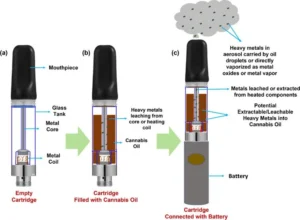When Were Weed Carts Invented
When Were Weed Carts Invented
The rise of cannabis vaping has opened up a new chapter in consuming this ancient plant. But how did these convenient and discreet devices come to be? This article delves into the history of cannabis vaping, exploring the evolution of vaporizer technology from its early roots to the development of the ubiquitous weed cart. We’ll trace the path from pioneering inventions to cannabis industry standards, uncovering the key players and breakthroughs that shaped the way we vape cannabis today.
When Were Weed Carts Invented
The history of cannabis vaping devices stretches back to the early 20th century. In 1927, the earliest documented vaporizer in the United States emerged with Joseph Robinson’s patent for a mechanical butane ignition device. This concept saw a significant leap forward by 1960, when Herbert Gilbert, a scrap metal dealer and Korean War veteran, patented the “Smokeless.” This device, remarkably similar to modern vaporizers, used a battery to heat a liquid, generating vapor for inhalation. While often hailed as the first electronic cigarette, the Smokeless notably lacked tobacco and nicotine. Despite this distinction, Gilbert’s invention has been a cornerstone for contemporary designs, and he expresses pride in its contribution to the development of safer, healthier alternatives.
When Did the First Vape Pen Come Out
The modern e-cigarette, which paved the way for contemporary vape pens, was invented in 2003 by Chinese pharmacist Hon Lik. However, the concept of nicotine aerosol generation devices dates back much earlier. Tobacco companies had been experimenting with these devices since as early as 1963. The first notable patent for such a device was filed by Herbert A. Gilbert, who created a smokeless non-tobacco cigarette in 1963. Although it wasn’t commercialized at the time, Gilbert’s invention laid important groundwork for future developments in vaping technology.
What Is the History of 510 Carts
The history of 510 cartridges or 510 carts, dates back to 2010. The term “510 thread” was coined by one of the pioneering vape battery manufacturers, Joyetech. (Recommended cart battery retailers: Boost!) Originally, this threading standard was used in the e-cigarette industry to ensure compatibility between and atomizers. The name “510” refers to the 10 threads at 5mm intervals on the battery connection.
As vaping technology evolved, the cannabis industry adopted the 510 threading standard due to its widespread use and compatibility. Over the years, the 510 thread has become the dominant standard for disposable cannabis cartridges, offering consumers and manufacturers a universal and reliable connection. Today, the majority of vape cartridges on the market, including those used for cannabis oil, utilize the 510 thread standard, highlighting its significance in the industry.
Why Is a Weed Pen Called a Cart
A weed pen is called a “cart” as a shorthand for “cartridge.” In the context of vape pens, the cartridge is the component that holds the cannabis oil or concentrate, which is vaporized for inhalation. This terminology is common because it succinctly refers to the replaceable part of the device that contains the active substance. Here’s a breakdown of the terminology and components:
Cartridge (or Cart): This is the upper part of the vape pen that includes the chamber filled with cannabis oil or concentrate and the mouthpiece through which the user inhales. It is called a “cart” for short.
Battery: This is the lower part of the vape pen that powers the device, heating the oil in the cartridge to produce vapor.
The term “dab cart” is specifically used when the cartridge contains concentrated forms of cannabis, known as dabs. The abbreviation “cart” has become common in the cannabis community due to its ease of use and widespread understanding.
What Was the First Weed Strain
The Hindu Kush strain is indeed one of the oldest and most well-known cannabis strains, originating from the Hindu Kush mountain range that spans Afghanistan, Pakistan, and India. This strain is an indica known for its potent effects and has been used for centuries to produce hashish.
The exact identity of the very first weed strain is difficult to pinpoint due to the ancient and widespread cultivation of cannabis. However, Hindu Kush is often cited as one of the original landrace strains. Landrace strains are cannabis strains that have naturally adapted to the specific geographical and climatic conditions of their native regions over thousands of years. Other notable landrace strains include:
Afghani: Originating from Afghanistan, this strain is known for its resinous buds and is often used to create hash.
Thai: A sativa strain from Thailand, known for its uplifting effects.
Panama Red: A sativa from Panama, famous in the 1960s and 1970s for its vibrant red hairs and potent effects.
Acapulco Gold: From Mexico, this sativa strain is renowned for its golden hairs and euphoric high.
Durban Poison: A sativa landrace strain from South Africa, known for its sweet smell and energetic effects.
These landrace strains form the genetic backbone of many modern hybrid strains. Their ancient origins and adaptation to their native environments have made them foundational in the cultivation and breeding of cannabis worldwide.
Final Words
The journey of cannabis vaping is a testament to human ingenuity and the constant push for safer and more convenient consumption methods. From Robinson’s early vaporizer to the widespread adoption of the 510 thread standard, each innovation has paved the way for the sleek and user-friendly devices we enjoy today. As technology continues to evolve, we can expect even more advancements in cannabis vaping, offering consumers a wider range of options and potentially even healthier alternatives.













1 comment